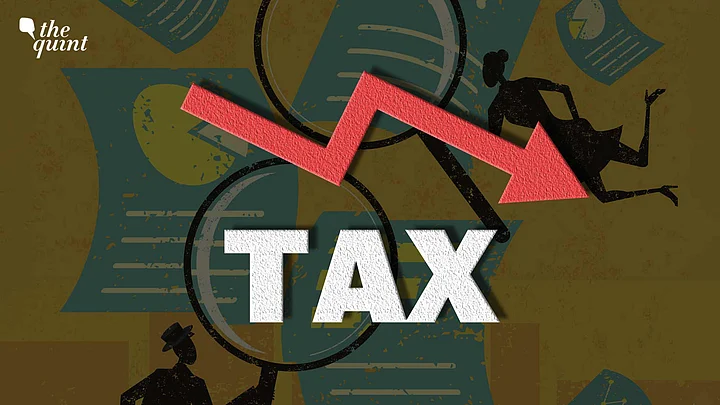In a rare feat, the Goods and Services Tax (GST) receipts collected by the Central and state governments crossed Rs 1.87 lakh crore in April and Rs 1.57 lakh crore in May 2023, increasing by about 11.5% year-on-year in both these months. This triggered obvious jubilation in some circles – with the government's GST collections also cited as a 'big vote' on the Indian economy, continuing to be the bright star globally.
However, it is curious how the official numbers released by the Controller General of Accounts (CGA) of the Gross Tax Revenue (GTR) for April on 31 May did not receive much attention.
The data informs us that the GTR – the total receipts of taxes of the Government of India before the share of states – recorded a surprisingly negative growth of a little over 6% (Rs 2,18,145 crore in April 2023 to Rs 2,32,266 crore in April 2022).
Corporate tax, personal income tax collections, and other components followed a similar trajectory. It is not just lower growth but an absolute decline in the taxes collected.
The contrast of increasing GST and declining GTR makes one ponder on the overall tax performance of the government and where it is headed.
What Explains Poor Overall Tax Performance of 2022–23
The financial year 2022-23 has just concluded on a good note with 22% growth in GST collections. The GTR, including GST, compensation tax, service tax, securities transaction tax, etc, grew by only 12.7% in and the Gross Domestic Product (GDP) grew nominally only by 16.1% based on the data released by the National Statistical Office (NSO). Thus, the tax buoyancy – the ratio of growth in taxes to growth of GDP – was barely 0.8 in this fiscal year; less than one being the surest indicator of poor tax performance.
Why was India’s tax performance that poor in 2022-23? What does this, coupled with April numbers, portend for 2023-24? It is vital to explore these fiscal issues thoroughly.
Direct taxes, such as corporate income taxes and personal income taxes, did significantly better with an impressive joint growth rate of 18% while the indirect taxes, GST, excise duties, and customs, did poorly.
Despite the super-profits tax imposed from July 2022 in order to leverage higher crude oil prices, the excise duties reduced significantly, thus recording an absolute decline of Rs 71,804 and marking a negative growth of 18.4%. The customs duties, too, recorded a piddling growth despite a spike in imports. On the other hand, the Central Goods and Services Tax (CGST) recorded a robust growth of 21.5% which had little impact on the overall indirect tax revenues.
Corporate profitability, after reaching its peak in 2021-22, witnessed quite a decent tax performance in 2022-23, recording an annual growth of 16%, though the quarterly growth kept generally declining during the year.
All the factors combined, the 2022-23 tax performance indicates tough times for the 2023-24 fiscal year.
Fiscal Year 2023–24: A Bumpy Start
It is clear from the CGA report that the tax performance has been on a downward slope at the very outset. This implores investigation of the reasons behind such a depletion, if there was a singular event that led to unpleasant results, and if the April figures are an outlier which might lead to a potential turnaround.
In April 2023, the government recorded a tremendous indirect tax growth of 25.6%. The direct taxes, however, recorded a negative growth of 9.2%. And so was corporate tax growth astoundingly low at -32%. The Integrated Goods and Services Tax (IGST) receipts were negative at Rs -9,304 crore.
It is, thus, important to look at the stipulations of the April tax numbers.
What To Expect?
Both corporate and personal income tax growth are likely to average in 2023-24 on account of moderation in corporate profits and salary growth. We will be lucky to see a double-digit growth in corporate taxes and personal income taxes, taken together.
IGST receipts in April could have been negative only if the government refunded or adjusted more IGST than the new tax receipts. Disproportionate growth in CGST receipts in April makes it quite obvious that the Government had withheld some of the IGST receipts of 2022-23 instead of distributing it in the last financial year. If we exclude the negative IGST receipts from April 2023 numbers, this will conversely make the 2022-23 numbers look worse.
Excise duties were reduced last in May 2022. Now, with the elections fast approaching, there is a strong likelihood of the government reducing petrol and diesel prices. The excise duties are likely to record further negative growth during 2023-24. Undoubtedly, custom duties are going to record a sharper negative growth in 2023-24.
CGST will most likely record overall 8-10% growth in 2023-24. On the whole, it seems most likely that India will record overall tax growth of between 6-8%.
Instead of citing every increase in GST as proof of good economic and tax performance, let us be more sanguine about tax performance during this year. There is likely to be pressure on government resources which might have to either borrow more than budgeted, or effect some expenditure cuts.
It is important to watch this space as the GDP and tax performance pan out in 2023-24.
(The author is the former Finance & Economic Affairs Secretary, Government of India; Author of two authoritative books on Indian economy and budgets- The $10 Trillion Dream and Commentary on Budget 2023-24. This is an opinion piece. The views expressed above are the author’s own. The Quint neither endorses nor is responsible for them.)
